Feasibility Study of Real-Time Monitoring of Pin Connection Wear Using Acoustic Emission
Abstract
1. Introduction
2. Experimental Setup
2.1. The Specimen
2.2. AE Test Equipment and Procedure
2.3. Inspecting the Pin Surface by Digital Microscopy
3. Results and Analyses
3.1. Results from AE and Analyses
3.2. Analyses Based on Surface Micrographs
4. Discussion
5. Conclusions
Author Contributions
Funding
Acknowledgments
Conflicts of Interest
References
- Liang, Y.; Li, D.; Kong, Q.; Song, G. Load monitoring of the pin-connected structure using time reversal technique and piezoceramic transducers-a feasibility study. IEEE Sens. J. 2016, 16, 7958–7966. [Google Scholar] [CrossRef]
- Yang, Y.; Divsholi, B.S.; Soh, C.K. A reusable pzt transducer for monitoring initial hydration and structural health of concrete. Sensors 2010, 10, 5193–5208. [Google Scholar] [CrossRef] [PubMed]
- Lynch, J.P.; Loh, K.J. A summary review of wireless sensors and sensor networks for structural health monitoring. Shock Vibr. Dig. 2006, 38, 91–128. [Google Scholar] [CrossRef]
- Song, G.; Wang, C.; Wang, B. Structural health monitoring (SHM) of civil structures. Appl. Sci. (Basel) 2017, 7, 1–502. [Google Scholar] [CrossRef]
- Andres Perez-Ramirez, C.; Yosimar Jaen-Cuellar, A.; Valtierra-Rodriguez, M.; Dominguez-Gonzalez, A.; Alfredo Osornio-Rios, R.; de Jesus Romero-Troncoso, R.; Pablo Amezquita-Sanchez, J. A two-step strategy for system identification of civil structures for structural health monitoring using wavelet transform and genetic algorithms. Appl. Sci. (Basel) 2017, 7, 111. [Google Scholar] [CrossRef]
- Na, W.S.; Baek, J. Impedance-based non-destructive testing method combined with unmanned aerial vehicle for structural health monitoring of civil infrastructures. Appl. Sci. (Basel) 2017, 7, 15. [Google Scholar] [CrossRef]
- Hu, D.; Guo, Y.; Chen, X.; Zhang, C. Cable force health monitoring of tongwamen bridge based on fiber bragg grating. Appl. Sci. (Basel) 2017, 7, 384. [Google Scholar] [CrossRef]
- Huo, L.; Wang, F.; Li, H.; Song, G. A fractal contact theory based model for bolted connection looseness monitoring using piezoceramic transducers. Smart Mater. Struct. 2017, 26, 104010. [Google Scholar] [CrossRef]
- Li, W.; Ho, S.C.M.; Patil, D.; Song, G. Acoustic emission monitoring and finite element analysis of debonding in fiber-reinforced polymer rebar reinforced concrete. Struct. Health Monit. 2017, 16, 674–681. [Google Scholar] [CrossRef]
- Li, W.; Xu, C.; Ho, S.C.M.; Wang, B.; Song, G. Monitoring concrete deterioration due to reinforcement corrosion by integrating acoustic emission and FBG strain measurements. Sensors (Basel) 2017, 17, 657. [Google Scholar] [CrossRef] [PubMed]
- Yang, X.Y.; Ishimaru, Y.; Iida, I.; Urakami, H. Application of modal analysis by transfer function to nondestructive testing of wood I: Determination of localized defects in wood by the shape of the flexural vibration wave. J. Wood Sci. 2001, 47, 304–310. [Google Scholar] [CrossRef]
- Yang, X.Y.; Amano, T.; Ishimaru, Y.; Iida, I. Application of modal analysis by transfer function to nondestructive testing of wood ii: Modulus of elasticity evaluation of sections of differing quality in a wooden beam by the curvature of the flexural vibration wave. J. Wood Sci. 2003, 49, 140–144. [Google Scholar] [CrossRef]
- Xu, J.; Hao, J.; Li, H.; Luo, M.; Guo, W.; Li, W. Experimental damage identification of a model reticulated shell. Appl. Sci. (Basel) 2017, 7, 362. [Google Scholar] [CrossRef]
- Yin, H.; Wang, T.; Yang, D.; Liu, S.; Shao, J.; Li, Y. A smart washer for bolt looseness monitoring based on piezoelectric active sensing method. Appl. Sci. (Basel) 2016, 6, 320. [Google Scholar] [CrossRef]
- Shao, J.; Wang, T.; Yin, H.; Yang, D.; Li, Y. Bolt looseness detection based on piezoelectric impedance frequency shift. Appl. Sci. (Basel) 2016, 6, 298. [Google Scholar] [CrossRef]
- Kong, Q.; Robert, R.H.; Silva, P.; Mo, Y.L. Cyclic crack monitoring of a reinforced concrete column under simulated pseudo-dynamic loading using piezoceramic-based smart aggregates. Appl. Sci. (Basel) 2016, 6, 341. [Google Scholar] [CrossRef]
- Jiang, T.; Kong, Q.; Patil, D.; Luo, Z.; Huo, L.; Song, G. Detection of debonding between fiber reinforced polymer bar and concrete structure using piezoceramic transducers and wavelet packet analysis. IEEE Sens. J. 2017, 17, 1992–1998. [Google Scholar] [CrossRef]
- Zhang, L.; Wang, C.; Song, G. Health status monitoring of cuplock scaffold joint connection based on wavelet packet analysis. Shock Vibr. 2015, 2015, 695845. [Google Scholar] [CrossRef]
- Jiang, T.; Kong, Q.; Wang, W.; Huo, L.; Song, G. Monitoring of grouting compactness in a post-tensioning tendon duct using piezoceramic transducers. Sensors 2016, 16, 1343. [Google Scholar] [CrossRef] [PubMed]
- Wang, F.; Huo, L.; Song, G. A piezoelectric active sensing method for quantitative monitoring of bolt loosening using energy dissipation caused by tangential damping based on the fractal contact theory. Smart Mater. Struct. 2017, 27, 015023. [Google Scholar] [CrossRef]
- Hu, X.; Zhu, H.; Wang, D. A study of concrete slab damage detection based on the electromechanical impedance method. Sensors 2014, 14, 19897–19909. [Google Scholar] [CrossRef] [PubMed]
- Annamdas, V.G.M.; Annamdas, K.K.K. Impedance based sensor technology to monitor stiffness of biological structures. In Advanced Environmental, Chemical, and Biological Sensing Technologies VII; VoDinh, T., Lieberman, R.A., Gauglitz, G., Eds.; SPIE: Bellingham, WA, USA, 2010; Volume 7673. [Google Scholar]
- Annamdas, K.K.K.; Annamdas, V.G.M. Piezo impedance sensors to monitor degradation of biological structure. In Advanced Environmental, Chemical, and Biological Sensing Technologies VII; VoDinh, T., Lieberman, R.A., Gauglitz, G., Eds.; SPIE: Bellingham, WA, USA, 2010; Volume 7673. [Google Scholar]
- Wang, D.; Wang, Q.; Wang, H.; Zhu, H. Experimental study on damage detection in timber specimens based on an electromechanical impedance technique and rmsd-based mahalanobis distance. Sensors (Basel) 2016, 16, 1765. [Google Scholar] [CrossRef] [PubMed]
- Wang, F.; Ho, S.C.M.; Huo, L.; Song, G. A Novel Fractal Contact-Electromechanical Impedance Model for Quantitative Monitoring of Bolted Joint Looseness. IEEE Access 2018, 6, 40212–40220. [Google Scholar] [CrossRef]
- Venugopal, V.P.; Wang, G. Modeling and analysis of lamb wave propagation in a beam under lead zirconate titanate actuation and sensing. J. Intell. Mater. Syst. Struct. 2015, 26, 1679–1698. [Google Scholar] [CrossRef]
- Zhao, X.; Li, W.; Song, G.; Zhu, Z.; Du, J. Scour monitoring system for subsea pipeline based on active thermometry: Numerical and experimental studies. Sensors 2013, 13, 1490–1509. [Google Scholar] [CrossRef] [PubMed]
- Zhao, X.; Li, W.; Zhou, L.; Song, G.-B.; Ba, Q.; Ou, J. Active thermometry based ds18b20 temperature sensor network for offshore pipeline scour monitoring using k-means clustering algorithm. Int. J. Distrib. Sens. Netw. 2013, 2013, 852090. [Google Scholar] [CrossRef]
- Xu, C.; Xie, J.; Zhang, W.; Kong, Q.; Chen, G.; Song, G. Experimental investigation on the detection of multiple surface cracks using vibrothermography with a low-power piezoceramic actuator. Sensors 2017, 17, 2705. [Google Scholar] [CrossRef] [PubMed]
- Parvasi, S.M.; Xu, C.; Kong, Q.; Song, G. Detection of multiple thin surface cracks using vibrothermography with low-power piezoceramic-based ultrasonic actuator-a numerical study with experimental verification. Smart Mater. Struct. 2016, 25, 055042. [Google Scholar] [CrossRef]
- Tang, J.; Soua, S.; Mares, C.; Gan, T.-H. A pattern recognition approach to acoustic emission data originating from fatigue of wind turbine blades. Sensors 2017, 17, 2507. [Google Scholar] [CrossRef] [PubMed]
- Tra, V.; Kim, J.; Khan, S.A.; Kim, J.-M. Bearing fault diagnosis under variable speed using convolutional neural networks and the stochastic diagonal levenberg-marquardt algorithm. Sensors (Basel) 2017, 17, 2834. [Google Scholar] [CrossRef] [PubMed]
- Nsugbe, E.; Ruiz-Carcel, C.; Starr, A.; Jennions, I. Estimation of fine and oversize particle ratio in a heterogeneous compound with acoustic emissions. Sensors (Basel) 2018, 18, 851. [Google Scholar] [CrossRef] [PubMed]
- De Agustina, B.; Maria Marin, M.; Teti, R.; Maria Rubio, E. Surface roughness evaluation based on acoustic emission signals in robot assisted polishing. Sensors 2014, 14, 21514–21522. [Google Scholar] [CrossRef] [PubMed]
- Chen, B.; Wang, Y.; Yan, Z. Use of acoustic emission and pattern recognition for crack detection of a large carbide anvil. Sensors (Basel) 2018, 18, 386. [Google Scholar] [CrossRef] [PubMed]
- Zelenyak, A.-M.; Hamstad, M.A.; Sause, M.G.R. Modeling of acoustic emission signal propagation in waveguides. Sensors 2015, 15, 11805–11822. [Google Scholar] [CrossRef] [PubMed]
- Sauerbrunn, C.M.; Kahirdeh, A.; Yun, H.; Modarres, M. Damage assessment using information entropy of individual acoustic emission waveforms during cyclic fatigue loading. Appl. Sci. (Basel) 2017, 7, 562. [Google Scholar] [CrossRef]
- Cho, C.W.; Lee, Y.Z. Wear-life evaluation of CRN-coated steels using acoustic emission signals. Surf. Coat. Technol. 2000, 127, 59–65. [Google Scholar] [CrossRef]
- Maya-Johnson, S.; Felipe Santa, J.; Toro, A. Dry and lubricated wear of rail steel under rolling contact fatigue—Wear mechanisms and crack growth. Wear 2017, 380–381, 240–250. [Google Scholar] [CrossRef]
- Ohtsu, M. The history and development of acoustic emission in concrete engineering. Mag. Concr. Res. 1996, 48, 321–330. [Google Scholar] [CrossRef]
- Aldahdooh, M.A.A.; Bunnori, N.M.; Johari, M.A.M. Damage evaluation of reinforced concrete beams with varying thickness using the acoustic emission technique. Constr. Build. Mater. 2013, 44, 812–821. [Google Scholar] [CrossRef]
- Invernizzi, S.; Lacidogna, G.; Carpinteri, A. Numerical models for the assessment of historical masonry structures and materials, monitored by acoustic emission. Appl. Sci. (Basel) 2016, 6, 102. [Google Scholar] [CrossRef]
- Sagasta, F.; Benavent-Climent, A.; Roldan, A.; Gallego, A. Correlation of plastic strain energy and acoustic emission energy in reinforced concrete structures. Appl. Sci. (Basel) 2016, 6, 84. [Google Scholar] [CrossRef]
- Shiroishi, J.; Li, Y.; Liang, S.; Kurfess, T.; Danyluk, S. Bearing condition diagnostics via vibration and acoustic emission measurements. Mech. Syst. Sig. Process. 1997, 11, 693–705. [Google Scholar] [CrossRef]
- Choudhury, A.; Tandon, N. Application of acoustic emission technique for the detection of defects in rolling element bearings. Tribol. Int. 2000, 33, 39–45. [Google Scholar] [CrossRef]
- Jun, S.; Wood, R.J.K.; Wang, L.; Care, I.; Powrie, H.E.G. Wear monitoring of bearing steel using electrostatic and acoustic emission techniques. Wear 2005, 259, 1482–1489. [Google Scholar]
- Gao, L.; Zai, F.; Su, S.; Wang, H.; Chen, P.; Liu, L. Study and application of acoustic emission testing in fault diagnosis of low-speed heavy-duty gears. Sensors 2011, 11, 599–611. [Google Scholar] [CrossRef] [PubMed]
- Qu, Y.; He, D.; Yoon, J.; Van Hecke, B.; Bechhoefer, E.; Zhu, J. Gearbox tooth cut fault diagnostics using acoustic emission and vibration sensors—A comparative study. Sensors 2014, 14, 1372–1393. [Google Scholar] [CrossRef] [PubMed]
- Svecko, R.; Kusic, D.; Kek, T.; Sarjas, A.; Hancic, A.; Grum, J. Acoustic emission detection of macro-cracks on engraving tool steel inserts during the injection molding cycle using pzt sensors. Sensors 2013, 13, 6365–6379. [Google Scholar] [CrossRef] [PubMed]
- Zou, S.; Yan, F.; Yang, G.; Sun, W. The identification of the deformation stage of a metal specimen based on acoustic emission data analysis. Sensors 2017, 17, 789. [Google Scholar] [CrossRef] [PubMed]
- Su, F.-Q.; Itakura, K.-I.; Deguchi, G.; Ohga, K. Monitoring of coal fracturing in underground coal gasification by acoustic emission techniques. Appl. Energy 2017, 189, 142–156. [Google Scholar] [CrossRef]
- Ge, M.; Mrugala, M.; Iannacchione, A.T. Microseismic monitoring at a limestone mine. Geotech. Geol. Eng. 2009, 27, 325–339. [Google Scholar] [CrossRef]
- Aggelis, D.G.; Strantza, M.; Louis, O.; Boulpaep, F.; Polyzos, D.; van Hemelrijck, D. Fracture of human femur tissue monitored by acoustic emission sensors. Sensors 2015, 15, 5803–5819. [Google Scholar] [CrossRef] [PubMed]
- Shepherd, S.V. Adapting acoustic monitoring technology to detect bulk solids flow. Sensors 2001, 18, 56–64. [Google Scholar]
- Yang, Z.; Jin, L.; Yan, Y.; Mei, Y. Filament breakage monitoring in fused deposition modeling using acoustic emission technique. Sensors (Basel) 2018, 18, 749. [Google Scholar] [CrossRef] [PubMed]
- Yao, Y.; Ju, X.; Lu, J.; Men, B. Acoustic emission and echo signal compensation techniques applied to an ultrasonic logging-while-drilling caliper. Sensors 2017, 17, 1351. [Google Scholar]
- Zhang, T.; Pang, F.; Liu, H.; Cheng, J.; Lv, L.; Zhang, X.; Chen, N.; Wang, T. A fiber-optic sensor for acoustic emission detection in a high voltage cable system. Sensors 2016, 16, 2026. [Google Scholar] [CrossRef] [PubMed]
- Absi Alfaro, S.C.; Cayo, E.H. Sensoring fusion data from the optic and acoustic emissions of electric arcs in the gmaw-s process for welding quality assessment. Sensors 2012, 12, 6953–6966. [Google Scholar] [CrossRef] [PubMed]
- Martini, A.; Troncossi, M.; Rivola, A. Leak detection in water-filled small-diameter polyethylene pipes by means of acoustic emission measurements. Appl. Sci. (Basel) 2017, 7, 2. [Google Scholar] [CrossRef]
- Liu, P.F.; Chu, J.K.; Liu, Y.L.; Zheng, J.Y. A study on the failure mechanisms of carbon fiber/epoxy composite laminates using acoustic emission. Mater. Des. 2012, 37, 228–235. [Google Scholar] [CrossRef]
- De Santis, S.; Tomor, A.K. Laboratory and field studies on the use of acoustic emission for masonry bridges. NDT E Int. 2013, 55, 64–74. [Google Scholar] [CrossRef]
- Geng, J.; Sun, Q.; Zhang, Y.; Cao, L.; Zhang, W. Studying the dynamic damage failure of concrete based on acoustic emission. Constr. Build. Mater. 2017, 149, 9–16. [Google Scholar] [CrossRef]
- Aggelis, D.G. Classification of cracking mode in concrete by acoustic emission parameters. Mech. Res. Commun. 2011, 38, 153–157. [Google Scholar] [CrossRef]
- Hearn, S.W.; Shield, C.K. Acoustic emission monitoring as a nondestructive testing technique in reinforced concrete. ACI Mater. J. 1997, 94, 510–519. [Google Scholar]
- Ouyang, C.S.; Landis, E.; Shah, S.P. Damage assessment in concrete using quantitative acoustic-emission. J. Eng. Mech. 1991, 117, 2681–2698. [Google Scholar] [CrossRef]
- Zaki, A.; Chai, H.K.; Aggelis, D.G.; Alver, N. Non-destructive evaluation for corrosion monitoring in concrete: A review and capability of acoustic emission technique. Sensors 2015, 15, 19069–19101. [Google Scholar] [CrossRef] [PubMed]
- Li, D.; Cao, H. Monitoring of temperature fatigue failure mechanism for polyvinyl alcohol fiber concrete using acoustic emission sensors. Sensors 2012, 12, 9502–9513. [Google Scholar] [CrossRef] [PubMed]
- Li, D.; Ou, J.; Lan, C.; Li, H. Monitoring and failure analysis of corroded bridge cables under fatigue loading using acoustic emission sensors. Sensors 2012, 12, 3901–3915. [Google Scholar] [CrossRef] [PubMed]
- Prem, P.R.; Murthy, A.R. Acoustic emission monitoring of reinforced concrete beams subjected to four-point-bending. Appl. Acoust. 2017, 117, 28–38. [Google Scholar] [CrossRef]
- ElBatanouny, M.K.; Ziehl, P.H.; Larosche, A.; Mangual, J.; Matta, F.; Nanni, A. Acoustic emission monitoring for assessment of prestressed concrete beams. Constr. Build. Mater. 2014, 58, 46–53. [Google Scholar] [CrossRef]
- Hay, D.R.; Cavaco, J.A.; Mustafa, V. Monitoring the civil infrastructure with acoustic emission: Bridge case studies. J. Acoust. Emission 2009, 27, 1–10. [Google Scholar]
- Huang, W.; Zhang, W.; Li, F. Acoustic emission source location using a distributed feedback fiber laser rosette. Sensors 2013, 13, 14041–14054. [Google Scholar] [CrossRef] [PubMed]
- Cui, X.; Yan, Y.; Guo, M.; Han, X.; Hu, Y. Localization of CO2 leakage from a circular hole on a flat-surface structure using a circular acoustic emission sensor array. Sensors 2016, 16, 1951. [Google Scholar] [CrossRef] [PubMed]
- Van Dijck, G.; Van Hulle, M.M. Information theory filters for wavelet packet coefficient selection with application to corrosion type identification from acoustic emission signals. Sensors 2011, 11, 5695–5715. [Google Scholar] [CrossRef] [PubMed]
- Yan, G.; Zhou, L. An optimal image-based method for identification of acoustic emission (ae) sources in plate-like structures using a lead zirconium titanate (pzt) sensor array. Sensors 2018, 18, 631. [Google Scholar] [CrossRef] [PubMed]
- Zhang, J.; Huang, Y.; Zheng, Y. A feasibility study on timber damage detection using piezoceramic-transducer-enabled active sensing. Sensors (Basel) 2018, 18, 1563. [Google Scholar] [CrossRef] [PubMed]
- Fan, S.; Zhao, S.; Qi, B.; Kong, Q. Damage evaluation of concrete column under impact load using a piezoelectric-based emi technique. Sensors (Basel) 2018, 18, 1591. [Google Scholar] [CrossRef] [PubMed]
- Gomez, M.J.; Corral, E.; Castejon, C.; Garcia-Prada, J.C. Effective crack detection in railway axles using vibration signals and wpt energy. Sensors (Basel) 2018, 18, 1603. [Google Scholar] [CrossRef] [PubMed]
- Lu, W.; Teng, J.; Li, C.; Cui, Y. Reconstruction to sensor measurements based on a correlation model of monitoring data. Appl. Sci. (Basel) 2017, 7, 243. [Google Scholar] [CrossRef]
- Jeon, H.; Lim, G.; Cho, S.J. IEEE Development of stretchable strain sensor using elastic fibrous membrane coated with conducting polymer. In Proceedings of the 2015 IEEE Sensors, Busan, Korea, 1–4 November 2015; pp. 999–1000. [Google Scholar]
- Du, G.; Li, Z.; Song, G. A pvdf-based sensor for internal stress monitoring of a concrete-filled steel tubular (CFST) column subject to impact loads. Sensors 2018, 18, 1682. [Google Scholar] [CrossRef] [PubMed]
- Ferdinand, M. Building an acoustic emission data analysis program. Sensors 1999, 16, 66. [Google Scholar]
- Strantza, M.; Aggelis, D.G.; de Baere, D.; Guillaume, P.; van Hemelrijck, D. Evaluation of shm system produced by additive manufacturing via acoustic emission and other ndt methods. Sensors 2015, 15, 26709–26725. [Google Scholar] [CrossRef] [PubMed]
- Heo, G.; Son, B.; Kim, C.; Jeon, S.; Jeon, J. Development of a wireless unified-maintenance system for the structural health monitoring of civil structures. Sensors 2018, 18, 1485. [Google Scholar] [CrossRef] [PubMed]
- Yang, D.; Guo, J.; Liu, C.; Liu, Q.; Zheng, R. A direct bicarbonate detection method based on a near-concentric cavity-enhanced raman spectroscopy system. Sensors 2017, 17, 2784. [Google Scholar] [CrossRef] [PubMed]
- Zhou, X.; Ji, X.; Wang, B.; Cheng, Y.; Ma, Z.; Choi, F.; Helmuth, B.; Xu, W. Pido: Predictive delay optimization for intertidal wireless sensor networks. Sensors 2018, 18, 1464. [Google Scholar] [CrossRef] [PubMed]
- De Marziani, C.; Urena, J.; Hernandez, A.; Mazo, M.; Garcia, J.J.; Jimenez, A.; Perez Rubio, M.d.C.; Alvarez, F.; Manuel Villadangos, J. Acoustic sensor network for relative positioning of nodes. Sensors 2009, 9, 8490–8507. [Google Scholar] [CrossRef] [PubMed]
- Fengming, Y.; Okabe, Y. Fiber-optic sensor-based remote acoustic emission measurement in a 1000 degc environment. Sensors 2017, 17, 2908. [Google Scholar] [CrossRef] [PubMed]
- Schmitt, M.; Olfert, S.; Rautenberg, J.; Lindner, G.; Henning, B.; Reindl, L.M. Multi reflection of lamb wave emission in an acoustic waveguide sensor. Sensors 2013, 13, 2777–2785. [Google Scholar] [CrossRef] [PubMed]
- Wei, P.; Han, X.; Xia, D.; Liu, T.; Lang, H. Novel fiber-optic ring acoustic emission sensor. Sensors 2018, 18, 215. [Google Scholar]
- Andrade Maia, L.H.; Abrao, A.M.; Vasconcelos, W.L.; Sales, W.F.; Machado, A.R. A new approach for detection of wear mechanisms and determination of tool life in turning using acoustic emission. Tribol. Int. 2015, 92, 519–532. [Google Scholar] [CrossRef]
- Mei, Y.; Yu, Z.; Yang, Z. Experimental investigation of correlation between attrition wear and features of acoustic emission signals in single-grit grinding. Int. J. Adv. Manuf. Technol. 2017, 93, 2275–2287. [Google Scholar]
- Kalogiannakis, G.; Quintelier, J.; De Baets, P.; Degrieck, J.; Van Hernelrijck, D. Identification of wear mechanisms of glass/polyester composites by means of acoustic emission. Wear 2008, 264, 235–244. [Google Scholar] [CrossRef]
- Hase, A.; Wada, M.; Mishina, H. Scanning electron microscope observation study for identification of wear mechanism using acoustic emission technique. Tribol. Int. 2014, 72, 51–57. [Google Scholar] [CrossRef]
- Karim, Z.; Nuawi, M.Z.; Ghani, J.A.; Ghazali, M.J.; Abdullah, S.; Mansor, N.I.I. Sliding wear evaluation of aluminum alloy (7075-T6) on hardened steel (AISI4340) via non-contact technique by I-kaz (tm) multi-level analysis. Wear 2015, 334, 99–104. [Google Scholar] [CrossRef]
- Rastegaev, I.A.; Merson, D.L.; Danyuk, A.V.; Afanasyev, M.A.; Vinogradov, A. Using acoustic emission signal categorization for reconstruction of wear development timeline in tribosystems: Case studies and application examples. Wear 2018, 410, 83–92. [Google Scholar] [CrossRef]
- Bhuiyan, M.S.H.; Choudhury, I.A.; Dahari, M.; Nukman, Y.; Dawal, S.Z. Application of acoustic emission sensor to investigate the frequency of tool wear and plastic deformation in tool condition monitoring. Measurement 2016, 92, 208–217. [Google Scholar] [CrossRef]
- Korchuganov, M.A.; Filippov, A.V.; Tarasov, S.Y.; Podgornyh, O.A.; Shamarin, N.N.; Filippova, E.O. An experimental modeling and acoustic emission monitoring of abrasive wear in a steel/diabase pair. In Advanced Materials with Hierarchical Structure for New Technologies and Reliable Structures, AIP Conference Proceedings 1783; Panin, V.E., Psakhie, S.G., Fomin, V.M., Eds.; AIP: Tomsk, Russia, September 2016. [Google Scholar]
- Hase, A.; Wada, M.; Mishina, H. Correlation of abrasive wear phenomenon and ae signals. J. Jpn. Soc. Tribol. 2006, 51, 752–759. [Google Scholar]
- Hase, A.; Wada, M.; Hirota, H. Correlation of material transfer phenomenon and AE signals in adhesive wear. J. Jpn. Soc. Tribol. 2005, 50, 808–815. [Google Scholar]
- Ji, X.; Ji, C.; Cheng, J.; Shan, Y.; Tian, S. Erosive wear resistance evaluation with the hardness after strain-hardening and its application for a high-entropy alloy. Wear 2018, 398, 178–182. [Google Scholar] [CrossRef]
- Shabalinskaya, L.A.; Golovanov, V.V.; Bubnova, E.S.; Melnikov, A.O.; Grigorev, A.V.; Prodanov, E.S. Tribodiagnostics of aviation reduction gears according to the stages of the surface fatigue wear for its units. J. Frict. Wear 2017, 38, 297–301. [Google Scholar] [CrossRef]
- Nouri, M.; Li, D.Y. Maximizing the benefit of aluminizing to az31 alloy by surface nanocrystallization for elevated resistance to wear and corrosive wear. Tribol. Int. 2017, 111, 211–219. [Google Scholar] [CrossRef]
- Hase, A.; Mishina, H.; Wada, M. Correlation between features of acoustic emission signals and mechanical wear mechanisms. Wear 2012, 292, 144–150. [Google Scholar] [CrossRef]
- Hisakado, T.; Warashina, T. Relationship between friction and wear properties and acoustic emission characteristics: Iron pin on hardened bearing steel disk. Wear 1998, 216, 1–7. [Google Scholar] [CrossRef]
- Wang, T.; Liu, S.; Shao, J.; Li, Y. Health monitoring of bolted joints using the time reversal method and piezoelectric transducers. Smart Mater. Struct. 2016, 25, 025001. [Google Scholar]
- Wang, T.; Song, G.; Wang, Z.; Li, Y. Proof-of-concept study of monitoring bolt connection status using a piezoelectric based active sensing method. Smart Mater. Struct. 2013, 22, 087001. [Google Scholar] [CrossRef]
- Wang, H.S.; Hung, C.L.; Chang, F.K. Bearing failure of bolted composite joints. Part I: Experimental characterization. J. Compos. Mater. 1996, 30, 1284–1313. [Google Scholar] [CrossRef]
- Hung, C.L.; Chang, F.K. Bearing failure of bolted composite joints. Part II: Model and verification. J. Compos. Mater. 1996, 30, 1359–1400. [Google Scholar] [CrossRef]
- Liang, Y.; Li, D.; Parvasi, S.M.; Song, G. Load monitoring of pin-connected structures using piezoelectric impedance measurement. Smart Mater. Struct. 2016, 25, 105011. [Google Scholar] [CrossRef]
- Huo, L.; Chen, D.; Kong, Q.; Li, H.; Song, G. Smart washer—A piezoceramic-based transducer to monitor looseness of bolted connection. Smart Mater. Struct. 2017, 26, 025033. [Google Scholar] [CrossRef]
- Colombo, S.; Forde, M.C.; Main, I.G.; Halliday, J.; Shigeishi, M. AE energy analysis on concrete bridge beams. Mater. Struct. 2005, 38, 851–856. [Google Scholar] [CrossRef]
- Sagasta, F.; Zitto, M.E.; Piotrkowski, R.; Benavent-Climent, A.; Suarez, E.; Gallego, A. Acoustic emission energy b-value for local damage evaluation in reinforced concrete structures subjected to seismic loadings. Mech. Syst. Sig. Process. 2018, 102, 262–277. [Google Scholar] [CrossRef]
- Ostby, E.; Thaulow, C.; Akselsen, O.M. Quantitative relation between acoustic emission signal amplitude and arrested cleavage microcrack size. Int. J. Fract. 2012, 177, 73–80. [Google Scholar] [CrossRef]
- Ridge, A.R.; Ziehl, P.H. Evaluation of strengthened reinforced concrete beams: Cyclic load test and acoustic emission methods. Aci Struct. J. 2006, 103, 832–841. [Google Scholar]
- Sasada, T.; Oike, M.; Emori, N. The effect of abrasive grain-size on the transition between abrasive and adhesive wear. Wear 1984, 97, 291–302. [Google Scholar] [CrossRef]

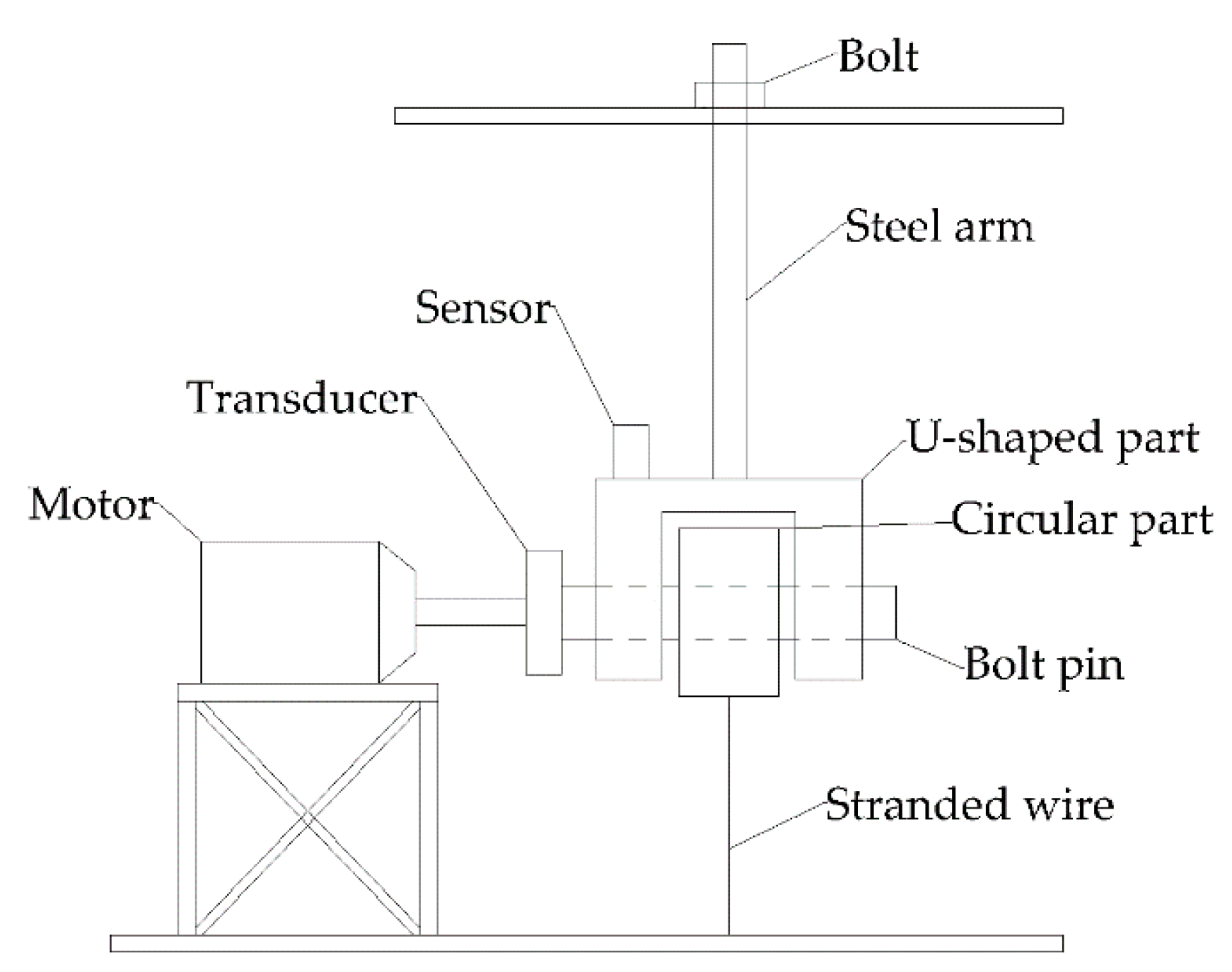
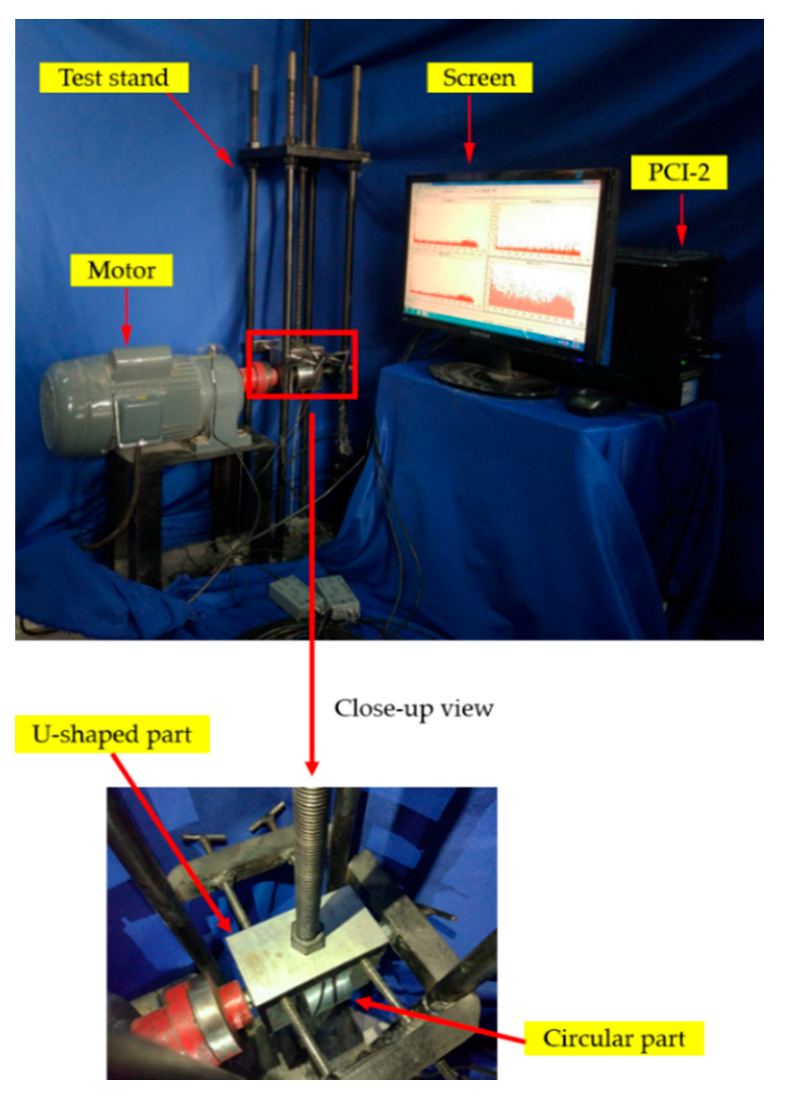
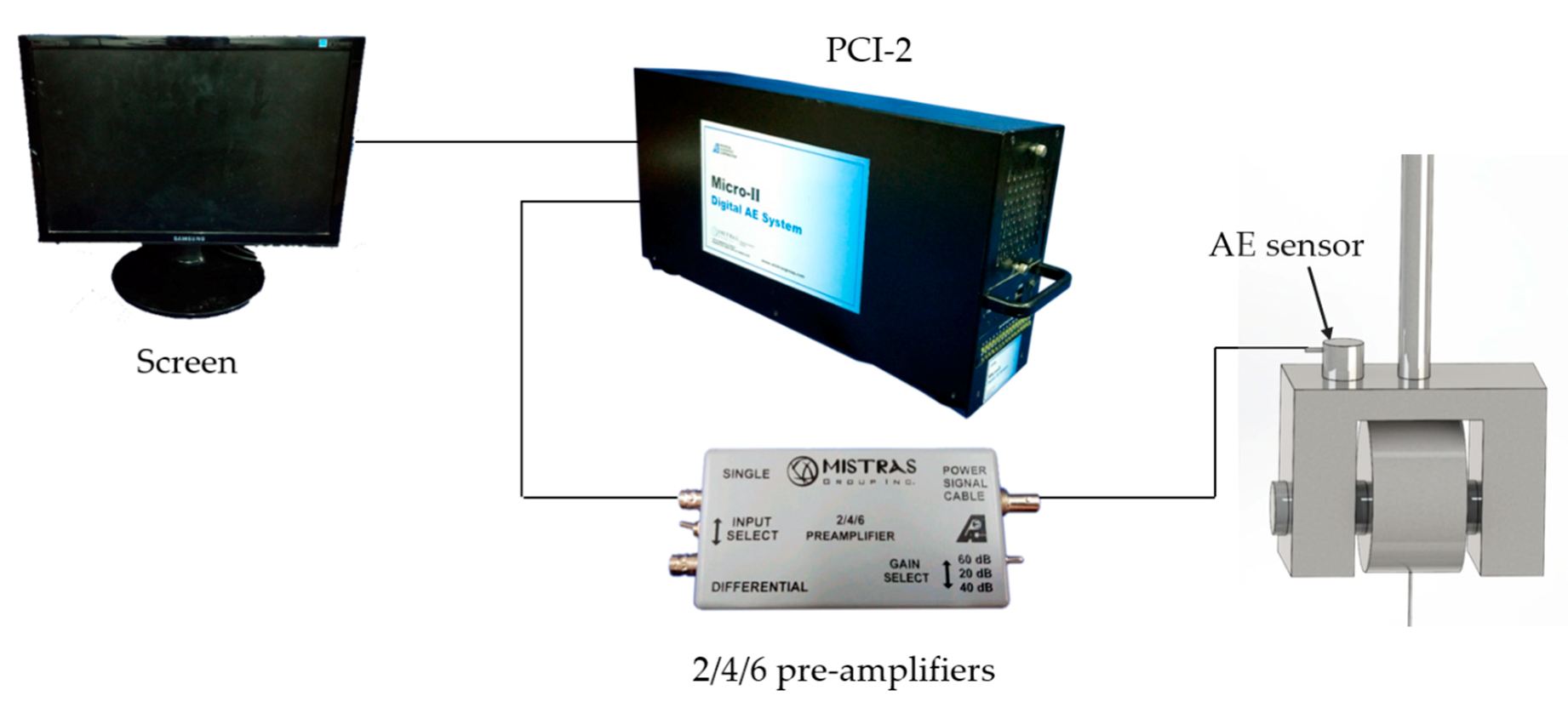


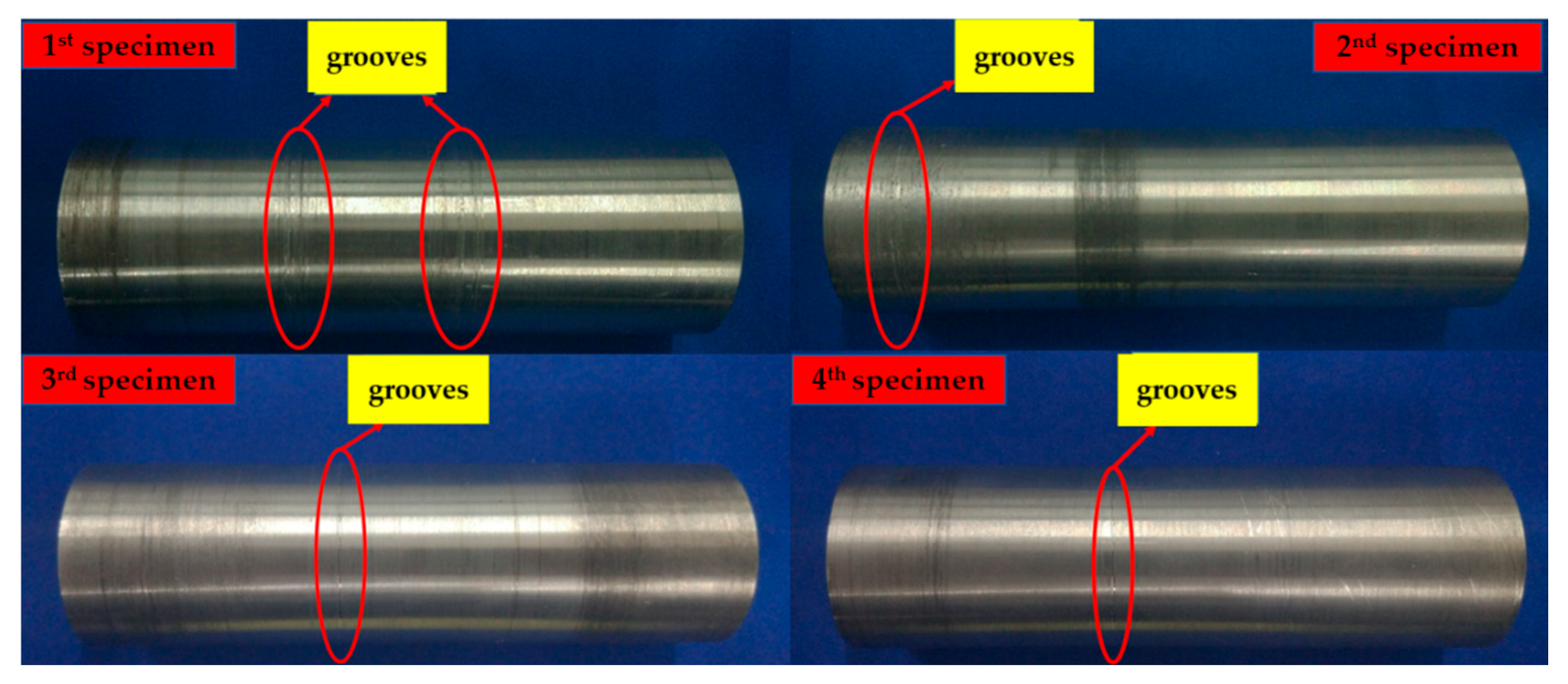
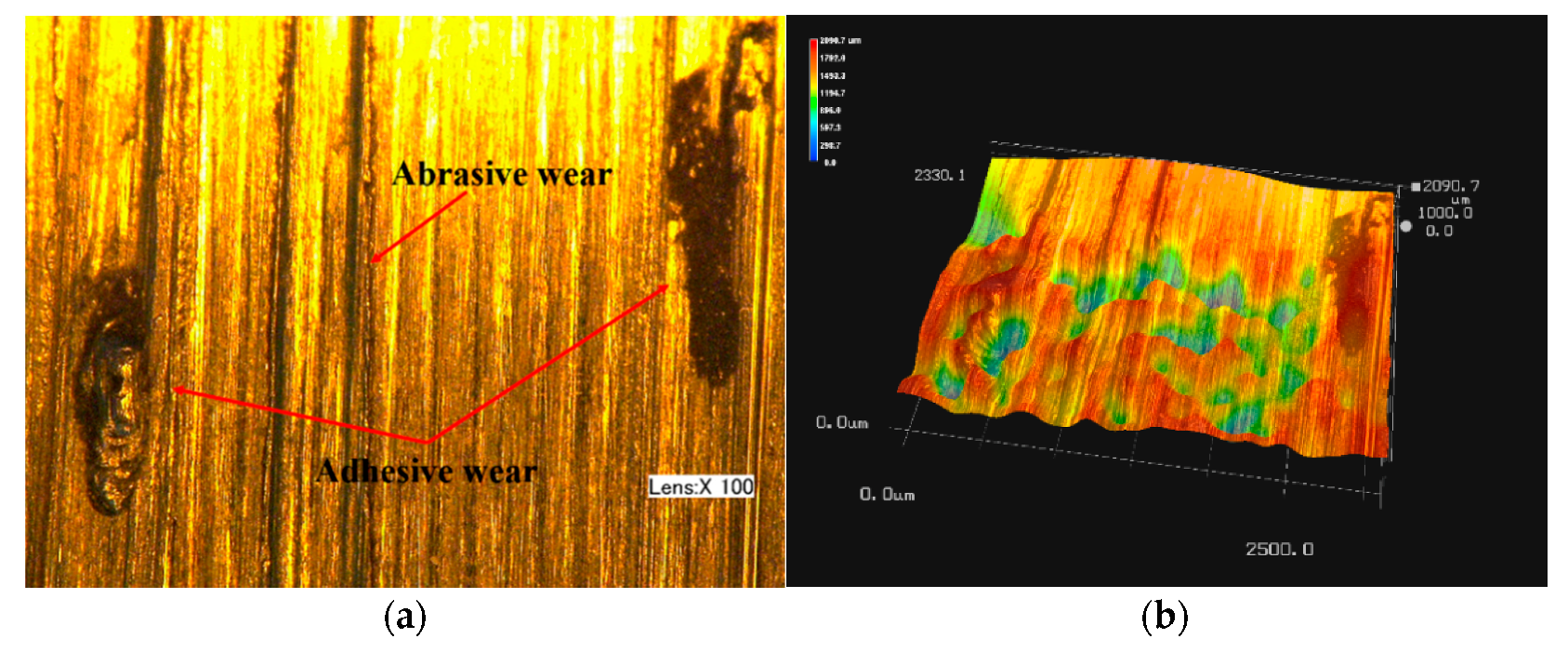
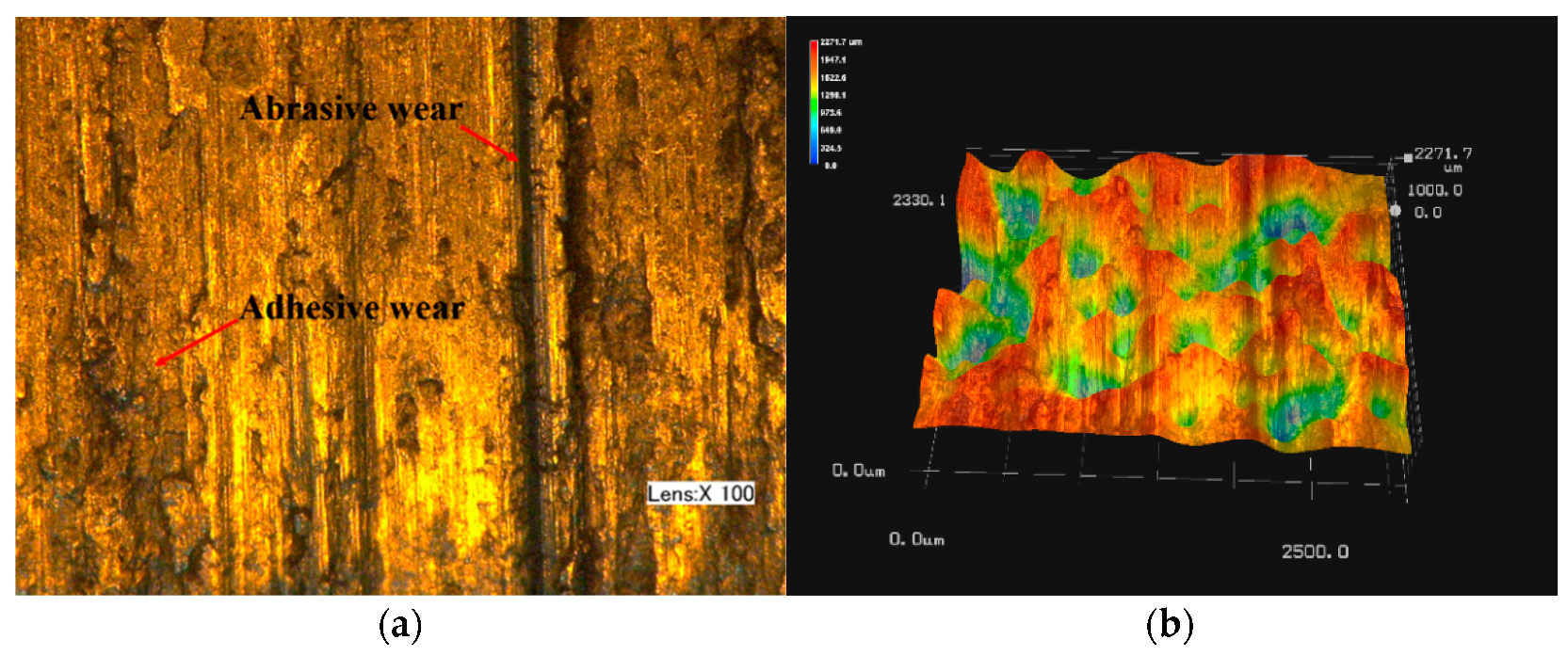
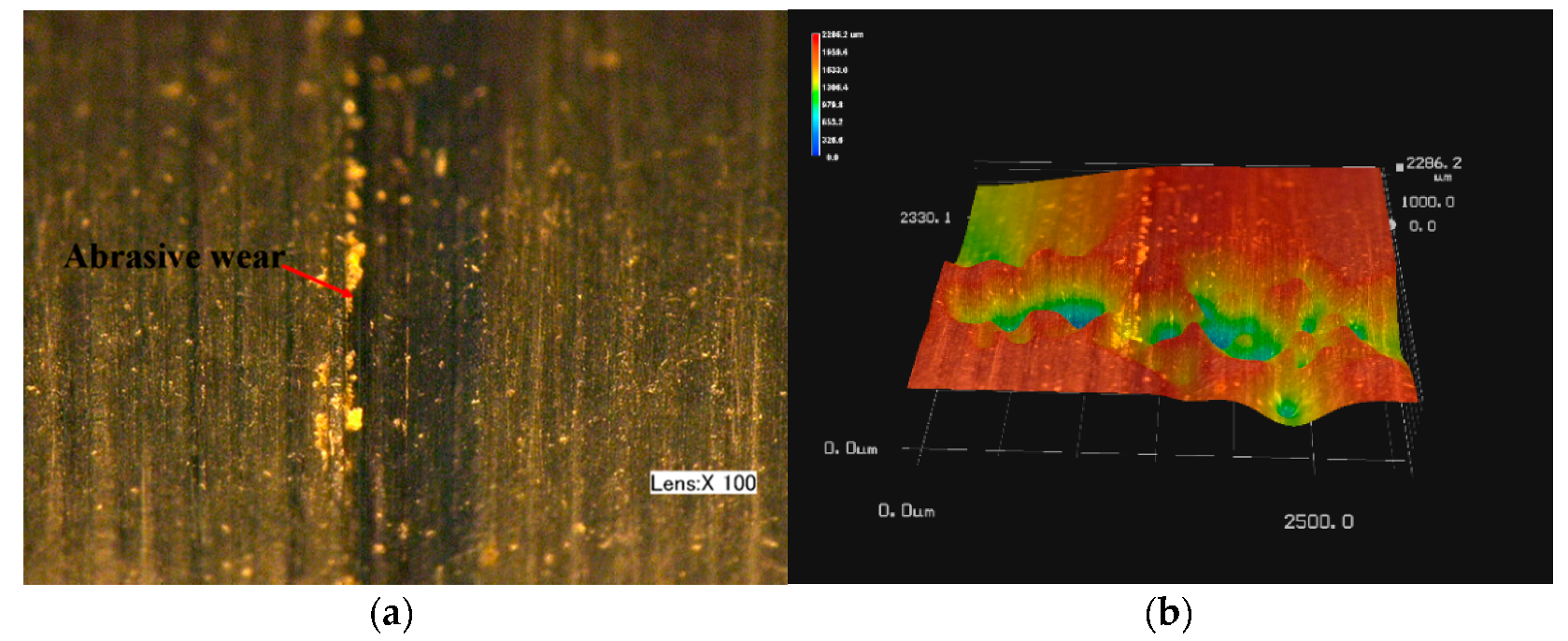
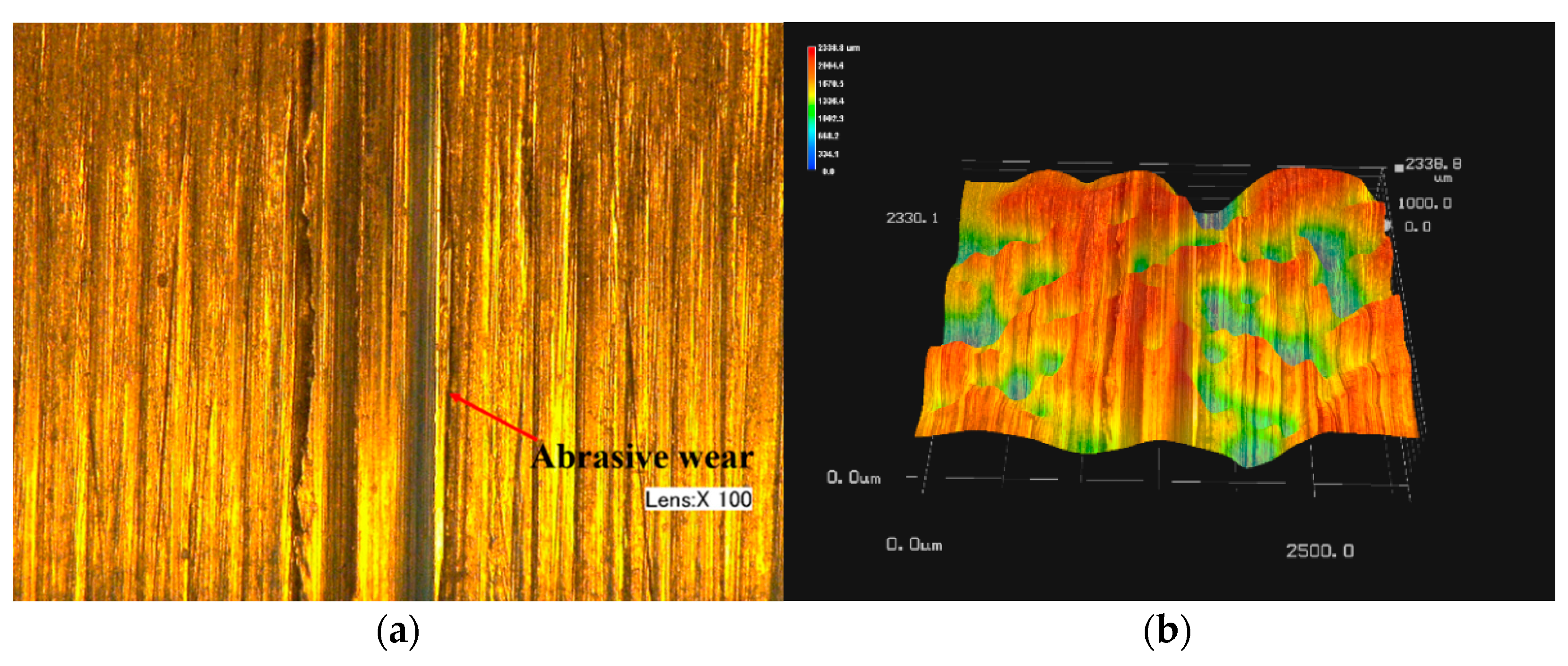
| Elements | C | Mn | P | S | Si | Cr | Ni |
|---|---|---|---|---|---|---|---|
| Proportion | ≤0.07 | ≤2.00 | ≤0.035 | ≤0.030 | ≤1.00 | 17.00~19.00 | 8.00~11.00 |
| Specimens No. | Grooves Location (Distance from the End Connected to Motor) (mm) | Numbers of Obvious Grooves | Average Depth of Wear (µm) |
|---|---|---|---|
| 1 | 40.1–47.7 and 65.7–72.2 | 12 | 2190.375 |
| 2 | 11.1 | 3 | 2137.9 |
| 3 | 40.35 and 66.6–70.15 | 4 | 2060.7 |
| 4 | 41.6 | 3 | 2235.3 |
© 2018 by the authors. Licensee MDPI, Basel, Switzerland. This article is an open access article distributed under the terms and conditions of the Creative Commons Attribution (CC BY) license (http://creativecommons.org/licenses/by/4.0/).
Share and Cite
Wang, J.; Huo, L.; Liu, C.; Peng, Y.; Song, G. Feasibility Study of Real-Time Monitoring of Pin Connection Wear Using Acoustic Emission. Appl. Sci. 2018, 8, 1775. https://doi.org/10.3390/app8101775
Wang J, Huo L, Liu C, Peng Y, Song G. Feasibility Study of Real-Time Monitoring of Pin Connection Wear Using Acoustic Emission. Applied Sciences. 2018; 8(10):1775. https://doi.org/10.3390/app8101775
Chicago/Turabian StyleWang, Jingkai, Linsheng Huo, Chunguang Liu, Yuanchen Peng, and Gangbing Song. 2018. "Feasibility Study of Real-Time Monitoring of Pin Connection Wear Using Acoustic Emission" Applied Sciences 8, no. 10: 1775. https://doi.org/10.3390/app8101775
APA StyleWang, J., Huo, L., Liu, C., Peng, Y., & Song, G. (2018). Feasibility Study of Real-Time Monitoring of Pin Connection Wear Using Acoustic Emission. Applied Sciences, 8(10), 1775. https://doi.org/10.3390/app8101775







